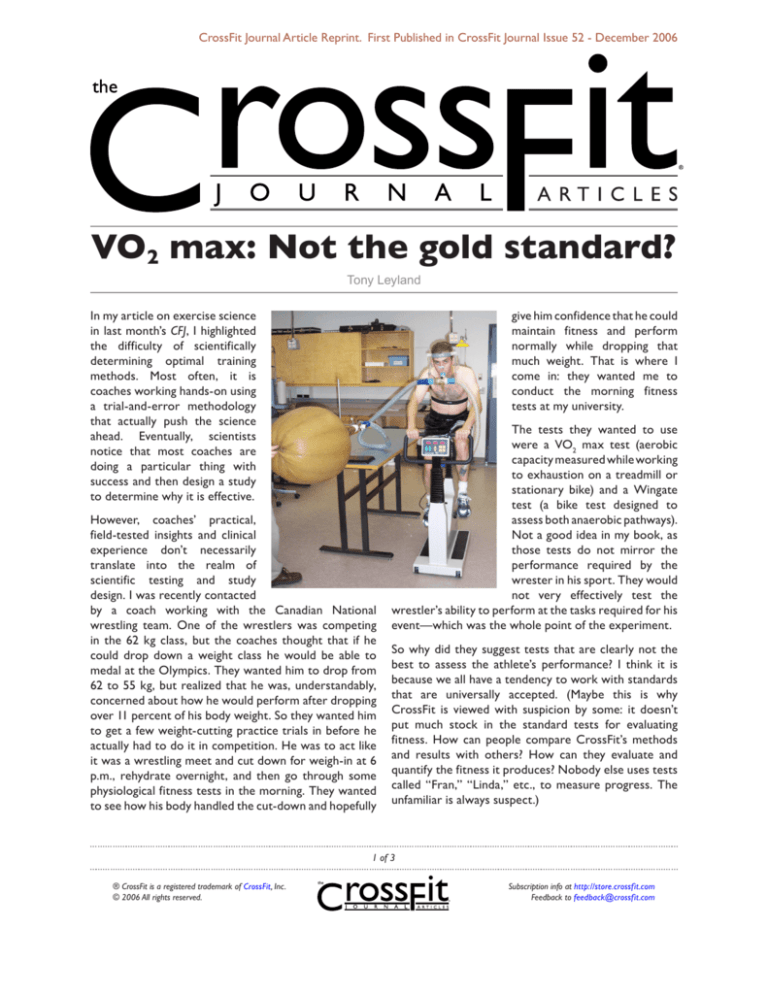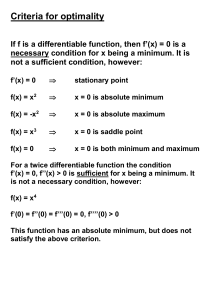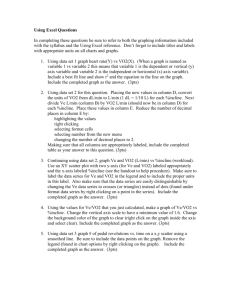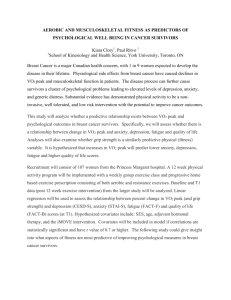
CrossFit Journal Article Reprint. First Published in CrossFit Journal Issue 52 - December 2006
VO2 max: Not the gold standard?
Tony Leyland
In my article on exercise science
in last month’s CFJ, I highlighted
the difficulty of scientifically
determining optimal training
methods. Most often, it is
coaches working hands-on using
a trial-and-error methodology
that actually push the science
ahead. Eventually, scientists
notice that most coaches are
doing a particular thing with
success and then design a study
to determine why it is effective.
give him confidence that he could
maintain fitness and perform
normally while dropping that
much weight. That is where I
come in: they wanted me to
conduct the morning fitness
tests at my university.
However, coaches’ practical,
field-tested insights and clinical
experience don’t necessarily
translate into the realm of
scientific testing and study
design. I was recently contacted
by a coach working with the Canadian National
wrestling team. One of the wrestlers was competing
in the 62 kg class, but the coaches thought that if he
could drop down a weight class he would be able to
medal at the Olympics. They wanted him to drop from
62 to 55 kg, but realized that he was, understandably,
concerned about how he would perform after dropping
over 11 percent of his body weight. So they wanted him
to get a few weight-cutting practice trials in before he
actually had to do it in competition. He was to act like
it was a wrestling meet and cut down for weigh-in at 6
p.m., rehydrate overnight, and then go through some
physiological fitness tests in the morning. They wanted
to see how his body handled the cut-down and hopefully
The tests they wanted to use
were a VO2 max test (aerobic
capacity measured while working
to exhaustion on a treadmill or
stationary bike) and a Wingate
test (a bike test designed to
assess both anaerobic pathways).
Not a good idea in my book, as
those tests do not mirror the
performance required by the
wrester in his sport. They would
not very effectively test the
wrestler’s ability to perform at the tasks required for his
event—which was the whole point of the experiment.
So why did they suggest tests that are clearly not the
best to assess the athlete’s performance? I think it is
because we all have a tendency to work with standards
that are universally accepted. (Maybe this is why
CrossFit is viewed with suspicion by some: it doesn’t
put much stock in the standard tests for evaluating
fitness. How can people compare CrossFit’s methods
and results with others? How can they evaluate and
quantify the fitness it produces? Nobody else uses tests
called “Fran,” “Linda,” etc., to measure progress. The
unfamiliar is always suspect.)
of 3
® CrossFit is a registered trademark of CrossFit, Inc.
© 2006 All rights reserved.
Subscription info at http://store.crossfit.com
Feedback to feedback@crossfit.com
VO2 max: Not the gold standard? (continued...)
The VO2 max test on a treadmill or stationary bike
measuring gas exchange is considered the “gold
standard” of laboratory tests to assess VO2 max (the
conventional measure of aerobic fitness), which is why
the wrestling coaches wanted to use it for their athlete.
But does it transfer to a wrestling match? Olympic
freestyle wrestling bouts consist of three rounds of two
minutes each. Wrestling is an exceptionally demanding
sport using multiple lines of action (pushes, pulls, and
static grips with both the arms and legs) and demanding
both cardiovascular endurance and muscular stamina,
so why not asses all these abilities in one test? You
could do three two-minute rounds of one minute of
thrusters and then one minute of pull-ups (like a Fran),
or maybe three sets of two minutes of clean and jerks
(like a Grace). This would tax the cardiovascular system
as well as muscular strength, power, and endurance, and
the athlete’s scores for each would measure changes
in his fitness. You could also develop a continuous sixminute test similar to Fight Gone Bad that would cover
many of these aspects and be indicative of the wrestler’s
VO2 max. To break the testing into a VO2 max test
(which would quantify how well he pumps blood to his
leg muscles and the stamina of those muscles) and a
Wingate test (which is a 30-second maximal-output
bike test to assess phosphagen and glycolytic energy
pathways) doesn’t adequately test the demands of the
sport.
If you wanted to assess other energy systems separately,
you could test the phosphagen system with a maximal
sprint (say, 60 meters) or, if you wanted a very shortduration power test, you could use a vertical jump or
clean and jerk. As for the glycolytic system…well, I think
any self-respecting CrossFitter could think of something
extremely intense using multiple muscle groups that you
could sustain for only 90 seconds before collapsing in a
heap on the floor.
When I discussed these issues with the wrestling coach,
I got a very positive response. It made a lot of sense to
him (as did the thought that he wouldn’t have to pay
for expensive tests). Also he now has complete control
on the timing of the test and he can repeat it more
frequently than relying on my university to conduct the
test.
Athletes are competitive by nature and love to challenge
themselves, so I frequently get calls asking me to
measure VO2 max and body fat percentages. As with
the wrestling coach, I usually tell people to save their
money. There is no need for expensive tests to measure
these variables and there is good science to prove you
shouldn’t. I’ll talk about percent body fat at another
time but this month I want to focus on VO2 max.
VO2 max is a measure of your body’s ability to take up
and utilize oxygen. VO2 max is measured by determining
the amount of oxygen in the inspired air and the expired
air. The difference is the amount of oxygen used by
the body. This is usually done by analyzing inspired
and expired gases while having the subject run on a
treadmill with ever-increasing speed and/or incline until
exhaustion.
At sea level, the most important physiological factors
that determine VO2 max in a given person are:
1. the ability of the heart to pump blood
2. the oxygen-carrying capacity of the blood
(hemoglobin content)
3. the ability of the working muscles to accept a
large blood supply (amount of capillarization
within a muscle)
4. the ability of the muscle cells to extract oxygen
from the capillary blood and use it to produce
energy (number of mitochondria and aerobic
enzymes)
Delivery of oxygen to the blood via the lungs is
important, but at sea level it is not a limiting factor.
Most people can get adequate amounts of air into the
lungs. The last two points in the list above are really why
I thought that a running or biking VO2 max test for the
wrestler wasn’t a good idea. A runner may have a large
stroke volume (amount of blood pumped by the heart
per beat, #1 above) but if you put him on a bike, his VO2
max measurement will come out lower than when he
is tested on a treadmill. Similarly, a cyclist will not do
as well on a treadmill. This is because of the difference
between systemic adaptations to the training impulse
and peripheral adaptations. Both runner and cyclist
have large stroke volumes but the runner’s quads cannot
accept as large a volume of blood and extract oxygen as
efficiently as the cyclist’s quads. Likewise, the hamstrings
and especially the ankle extensors (gastrocnemius and
soleus) of the runner are able to receive larger amounts
of blood and extract oxygen more effectively than those
of the cyclist. So VO2 max is specific to what you are
doing. In truth, there is no single, movement-agnostic
of 3
® CrossFit is a registered trademark of CrossFit, Inc.
© 2006 All rights reserved.
Subscription info at http://store.crossfit.com
Feedback to feedback@crossfit.com
VO2 max: Not the gold standard? (continued...)
VO2 max. There is a “running VO2 max,” a “cycling VO2
max,” a “thruster VO2 max,” etc.
The highest VO2 maximums recorded are for crosscountry skiers, as they utilize the most muscle tissue
in their event. I wonder what the VO2 max of an elite
CrossFit athlete would be while doing thrusters. You
could have a series of barbells set up with different
weights and increase the weight being thrusted every
three minutes until the athlete couldn’t sustain that
power output (similar to increasing the speed and/
or inclination of the treadmill). Not an easy test to
administer, but it is interesting to consider. The VO2
max recorded would undoubtedly be a very high value.
Another important point to keep in mind about
measuring athletic performance is that there is daily
variation in our physiological parameters. If you measure
your heart rate upon waking each morning, it will vary
from day to day. So will the maximum heart rate you
can achieve on any given day. It has been reported that
there can be up to an 8% variation in the VO2 max
due to this natural daily variation (we are not robots
responding to stimuli exactly the same way every time).
So why pay for one VO2 max test when you are trying
to determine change? You need at least two measures.
But even two tests aren’t ideal, as the difference is likely
to be affected by daily variation and other factors such
as hydration, nutrition, and environmental temperature,
rather than changed VO2 max per se.
So the best thing is to have simple tests such as a 5k run
that you can easily repeat six or seven or more times
a year. If your time improves consistently, you know
your running VO2 max has improved. Over the year
and multiple tests, variation due to factors other than
improved running VO2 will cancel out. This is why it is
so easy to test yourself while following CrossFit: the
benchmark workouts become the standardized tests.
You might not hit a PR every time, but you will see
which direction you are heading in and how steep the
trend curve is.
If you actually want a specific numeric measure of your
VO2 max (in ml of oxygen utilized per kg of body weight
per minute), you can run a 1.5-mile test (6 laps of a
standard 400-meter track) or run for as far as you can
on the track in 12 minutes. The links below will take you
to calculators that will estimate your VO2 max based on
your results:
• http://www.exrx.net/Calculators/OneAndHalf.html
• http://www.exrx.net/Calculators/MinuteRun.html
Sure, there are errors in these predictions compared
to a test that actually measures the O2 content in your
inspired and expired breath (the gold standard of testing,
remember), but they are free and repeatable whenever
you can find a 400-meter track and a stopwatch.
Not a runner? Test yourself at 150 wall-ball shots for
time. If over the year your time decreases, your VO2
max for wall ball has improved. And that is good to know.
However, you must be able to sustain any movement
you want to use to test VO2 max continuously for about
6 minutes or more. If wall ball with a 20-pound ball
overloads your arms so that you have to break sets and
rest, it wouldn’t be the best choice for evaluating VO2
max. Using a lighter ball (and maybe even adding to the
number of shots) so that you can work continuously for
6 minutes or more would make it work as a test of your
wall-ball VO2 max. So for anyone thinking of getting
an expensive fitness test done, don’t bother. Spend
your money on useful things, like the CrossFit Journal or
another medicine ball or another set of rings so your
friends can join you in actually improving your fitness
rather than worrying about how to quantify it.
Tony Leyland is Senior Lecturer at the School of Kinesiology at Simon Fraser University in Vancouver,
Canada. He has taught at the university level for 24 years and has been heavily involved in competitive
sports such as soccer, tennis, squash, and rugby as both an athlete and a coach for over 40 years. He is
a professional member of the National Strength and Conditioning Association, a Canadian National Blicensed soccer coach, and a level-1 CrossFit trainer.
of 3
® CrossFit is a registered trademark of CrossFit, Inc.
© 2006 All rights reserved.
Subscription info at http://store.crossfit.com
Feedback to feedback@crossfit.com








